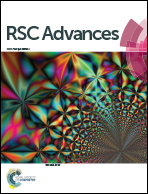Enhanced photocatalytic activity of magnetically separable bactericidal CuFe2O4-embedded Ag-deposited ZnO nanosheets
Abstract
Mineralization of organic pollutants by semiconductor-photocatalysis is an emerging technique but recovery of the photocatalyst nanoparticles is a hindrance for putting this technology into practice. Magnetic separation is feasible if a magnetic core is implanted in the photocatalyst particle. An iron oxide core, because of the conduction and valence band potentials, promotes electron–hole recombination in the core/shell photocatalyst and thus suppresses the photocatalytic activity. Here we present for the first time, the synthesis of magnetically recoverable bactericidal CuFe2O4-encapsulated Ag-deposited ZnO nanosheets for enhanced photocatalytic mineralization of dyes; the CB edge of the CuFe2O4 core does not induce charge carrier recombination. The nanosheets were obtained by a two-step synthesis of a hydrothermal method followed by photodeposition. High resolution scanning and transmission electron microscopies, selected area electron and X-ray diffractometries, vibrating sample magnetometry, and energy dispersive X-ray, Raman, solid state electrochemical impedance, UV visible diffuse reflectance, photoluminescence and time-correlated single photon counting lifetime spectroscopies show encapsulation of CuFe2O4 in Ag-deposited ZnO nanosheets. The synthesized composite nanosheets show enhanced photocatalytic activity. The synthesized nanosheets are a trifunctional material. The photocatalyst is photostable, reusable and magnetically separable. Furthermore, it exhibits excellent bactericidal activity.


 Please wait while we load your content...
Please wait while we load your content...